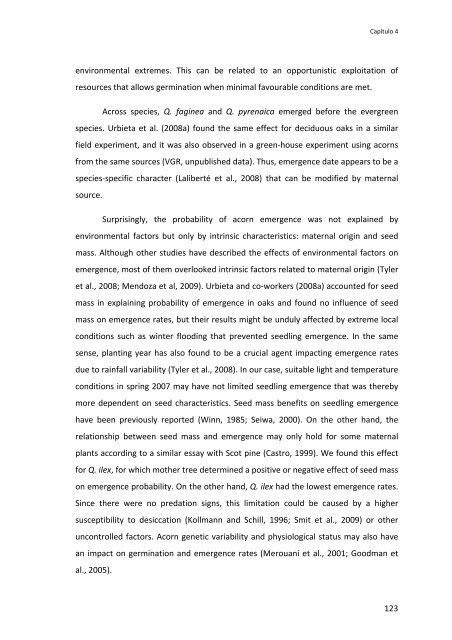Establecimiento de cuatro especies de Quercus en el sur de la ...
Establecimiento de cuatro especies de Quercus en el sur de la ...
Establecimiento de cuatro especies de Quercus en el sur de la ...
Create successful ePaper yourself
Turn your PDF publications into a flip-book with our unique Google optimized e-Paper software.
Capítulo 4<br />
<strong>en</strong>vironm<strong>en</strong>tal extremes. This can be r<strong>el</strong>ated to an opportunistic exploitation of<br />
resources that allows germination wh<strong>en</strong> minimal favourable conditions are met.<br />
Across species, Q. faginea and Q. pyr<strong>en</strong>aica emerged before the evergre<strong>en</strong><br />
species. Urbieta et al. (2008a) found the same effect for <strong>de</strong>ciduous oaks in a simi<strong>la</strong>r<br />
fi<strong>el</strong>d experim<strong>en</strong>t, and it was also observed in a gre<strong>en</strong>‐house experim<strong>en</strong>t using acorns<br />
from the same sources (VGR, unpublished data). Thus, emerg<strong>en</strong>ce date appears to be a<br />
species‐specific character (Laliberté et al., 2008) that can be modified by maternal<br />
source.<br />
Surprisingly, the probability of acorn emerg<strong>en</strong>ce was not exp<strong>la</strong>ined by<br />
<strong>en</strong>vironm<strong>en</strong>tal factors but only by intrinsic characteristics: maternal origin and seed<br />
mass. Although other studies have <strong>de</strong>scribed the effects of <strong>en</strong>vironm<strong>en</strong>tal factors on<br />
emerg<strong>en</strong>ce, most of them overlooked intrinsic factors r<strong>el</strong>ated to maternal origin (Tyler<br />
et al., 2008; M<strong>en</strong>doza et al, 2009). Urbieta and co‐workers (2008a) accounted for seed<br />
mass in exp<strong>la</strong>ining probability of emerg<strong>en</strong>ce in oaks and found no influ<strong>en</strong>ce of seed<br />
mass on emerg<strong>en</strong>ce rates, but their results might be unduly affected by extreme local<br />
conditions such as winter flooding that prev<strong>en</strong>ted seedling emerg<strong>en</strong>ce. In the same<br />
s<strong>en</strong>se, p<strong>la</strong>nting year has also found to be a crucial ag<strong>en</strong>t impacting emerg<strong>en</strong>ce rates<br />
due to rainfall variability (Tyler et al., 2008). In our case, suitable light and temperature<br />
conditions in spring 2007 may have not limited seedling emerg<strong>en</strong>ce that was thereby<br />
more <strong>de</strong>p<strong>en</strong><strong>de</strong>nt on seed characteristics. Seed mass b<strong>en</strong>efits on seedling emerg<strong>en</strong>ce<br />
have be<strong>en</strong> previously reported (Winn, 1985; Seiwa, 2000). On the other hand, the<br />
r<strong>el</strong>ationship betwe<strong>en</strong> seed mass and emerg<strong>en</strong>ce may only hold for some maternal<br />
p<strong>la</strong>nts according to a simi<strong>la</strong>r essay with Scot pine (Castro, 1999). We found this effect<br />
for Q. ilex, for which mother tree <strong>de</strong>termined a positive or negative effect of seed mass<br />
on emerg<strong>en</strong>ce probability. On the other hand, Q. ilex had the lowest emerg<strong>en</strong>ce rates.<br />
Since there were no predation signs, this limitation could be caused by a higher<br />
susceptibility to <strong>de</strong>siccation (Kollmann and Schill, 1996; Smit et al., 2009) or other<br />
uncontrolled factors. Acorn g<strong>en</strong>etic variability and physiological status may also have<br />
an impact on germination and emerg<strong>en</strong>ce rates (Merouani et al., 2001; Goodman et<br />
al., 2005).<br />
123

















